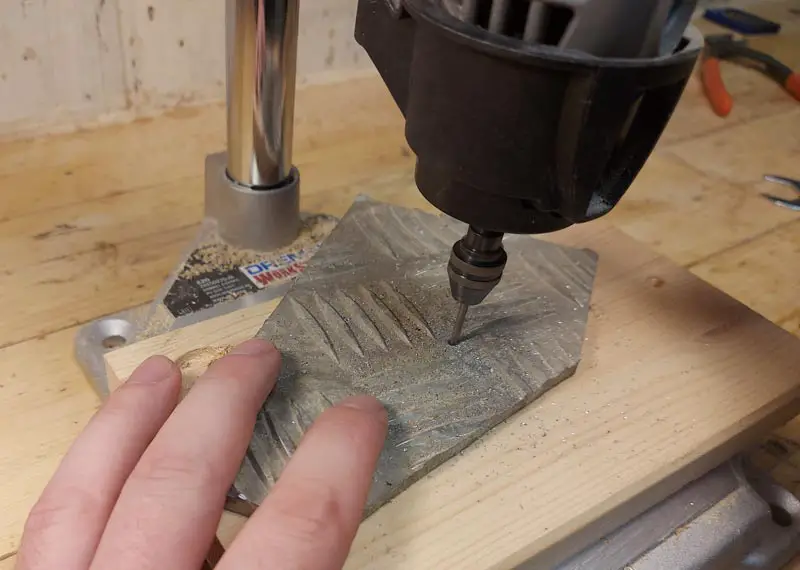
Disclosure: This post may contain affiliate links, meaning I get a commission if you decide to make a purchase through my links, at no extra cost to you.
Drilling holes is one of the basic tasks that a Dremel is useful for. A Dremel is a great tool for drilling smaller holes in many different materials, but what types of materials will a Dremel actually be able to drill through? And how is it done?
A Dremel can drill holes in wood, metal, stone, glass, plastic, plexiglass, tile, and most other materials. For the harder and more brittle materials like glass and stone, we use diamond bits to drill the holes. For the softer materials like wood and metal, we use drill bits to drill the holes.
By the end of this article you will know how to drill through the different materials with a Dremel, what bits to use to do it, and get some tips and tricks for drilling holes with a Dremel and rotary tools.
This Article Includes:
- General Tips For Drilling Holes
- Drilling Holes In Wood
- Drilling Holes In Metal
- Drilling Holes In Stone
- Drilling Holes In Glass
- Drilling Holes In Plastic
General Tips For Drilling Holes With A Dremel
One of the biggest advantages of drilling holes with a Dremel is the small size of the tool. The small size allows you to have good accuracy even when drilling holes free hand.
The small size of the Dremel also means you can use smaller drill bits without breaking them.
The smallest drill bit I have for the Dremel is 0.8mm or 0.03 inches and is great for making minute holes in wood.
A Dremel will also be able to use many different types of bits, which gives you the ability to drill through a wide range of materials that normal drill bits can’t, like stone and glass.
1. Use The Dremel Work Station (Drill Press)
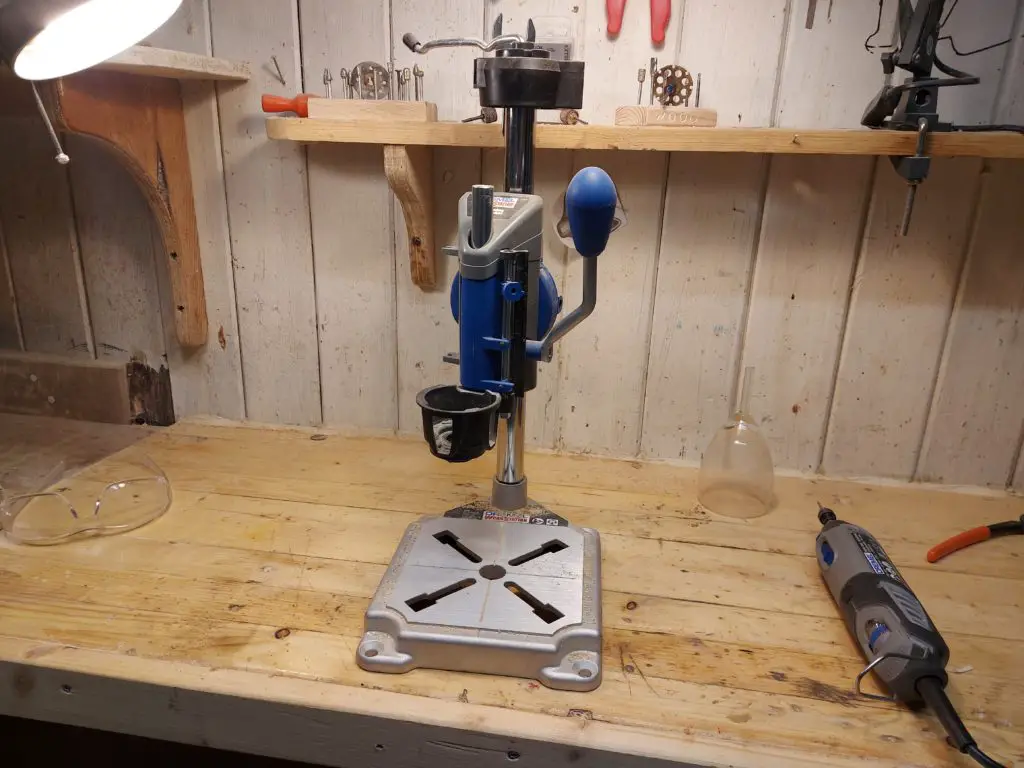
The Dremel Work Station 220-01 (Amazon) is a great attachment to make drilling easier with the Dremel. The workstation basically transforms the Dremel into a small drill press.
This makes you able to drill holes at a 90-degree angle to the workpiece.
The Dremel workstation is compatible with the larger Dremel models like the Dremel 3000, 4000, 8220, 4300, 8260, and some others.


2. Use A Dremel Flex Shaft
The Flex Shaft #225 (Amazon) is an extendible shaft that you can connect to the Dremel motor and makes the Dremel easier to handle and more maneuverable.
With the flex shaft, you can easily drill holes free hand.
The Flex Shaft is the attachment I use the most for drilling with the Dremel.
The flex shaft attachment is compatible with the Dremel models 4000, 3000, 4300, 4200, Lite, 100, 200, 8220, 8260, and more
3. Use Cutting Guide For Drilling Consistent Depths
The Cutting Guide #565 is an attachment that lets you set the depth of the cut you want to make. This gives you the ability to consistently drill holes with the same depth.
For Example, if you are making a bit stand for your Dremel bits, where you need to drill a lot of holes with the same depth. Then the cutting guide would be of great assistance.
4. Use The Right Bit For The Material You Are Drilling In
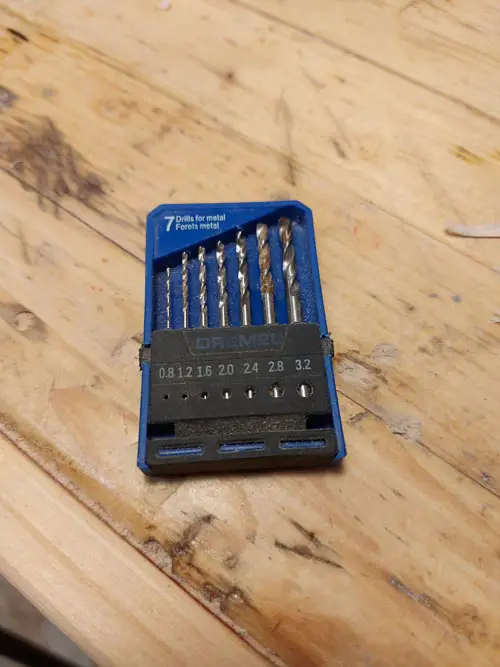
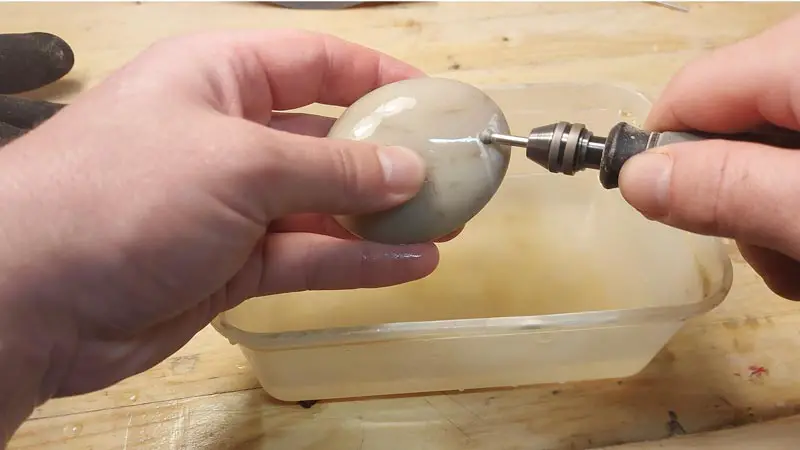
This probably goes without saying, but you should use the proper bits for the different materials. But this can be easier said than done with all the different bits that you have to choose from.
So I can understand if you guys get confused about what bits to use sometimes. I know I do. But here is a simple overview of the different drilling bits we use for drilling different materials.
- Wood And Metal = Drill Bits
- Glass And Stone = Diamond Bits
I will explain more about drilling in the different materials in the detailed sections below.
5. Experiment With The RPMs
I usually set my RPM to about 20 000 and let it stay there for most tasks. That is just a comfortable speed for my use.
But if you want to drill holes effectively it is important to experiment with the different RPM ranges.
When drilling wood with a Dremel, it can be beneficial to reduce the RPM to about 10 to 15 thousand. This reduces the friction, reduces heat buildup and allows you more control over the cut.
When drilling harder materials like stone and glass with a Dremel, it can be beneficial to increase the RPMs to 25 to 30 thousand. Since you are already cooling down the cut with water and all you want to achieve is to grind your way through the material.
Drilling A Hole In Wood With A Dremel
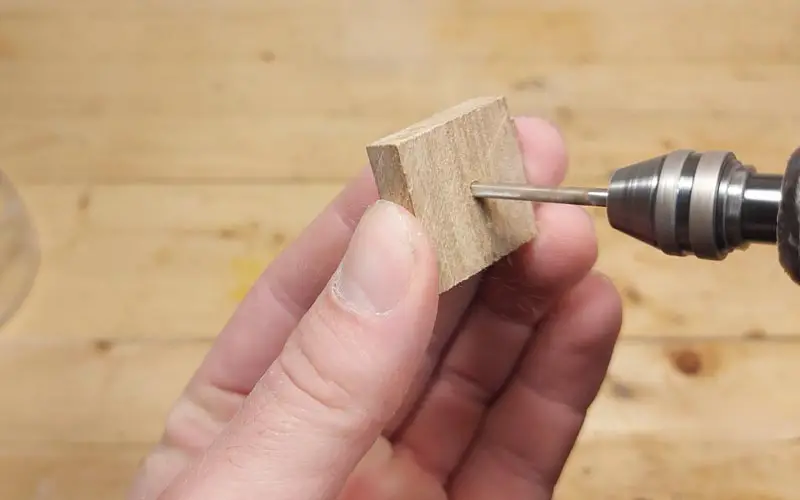
When drilling a hole in the wood with a Dremel we use the Dremel Wood Drill Bits #636 or the Dremel Multi-Purpose Drill Bits #628. Simply mark the spot where you want to make the hole, select the size of the drill bit, secure the workpiece, and start drilling.
The Wood Drill Bits #636 (3mm – 6mm) are great for making straight and accurate holes in wood. These are brad point drill bits, which means they have a pointy tip and edges that initiate the cut very easily and also keep the cut straight.
The Multi-Purpose drill bits #628 (0.8mm – 7mm) is actually meant to be used for metal, but can also be used on wood. These have a tendency to slip when initiating the cut, so it is a good idea to use a center punch to make a dent in the wood before you make the cut.
Here is a list of things that are important to think about when drilling wood:
- Safety Glasses, Dust Mask
- Mark Where You Wanna drill
- Choose The Size Of The Drill Bit
- Secure The Work Piece
- Center Punch The Marking (depending on what drill bit)
- Set A Mid Range Rpm (10 000 – 20 000)
- Have Good Lighting
- Start The Dremel
- Slowly Approach The Wood At The Right Angle
- Keep Light Pressure
- If Smoke Occurs, Use Less Pressure
- Or Take The Bit Out And Let It Cool Down
- And Voila, You’ve Done It
And as mentioned before, if you want to drill the same depth for several cuts. Use the Cutting Guide #565 for controlling the depth.
Use The Flex Shaft for more free-hand control
Use the Work Station to make the Dremel into a Drill Press
Drilling Holes In Metal With A Dremel
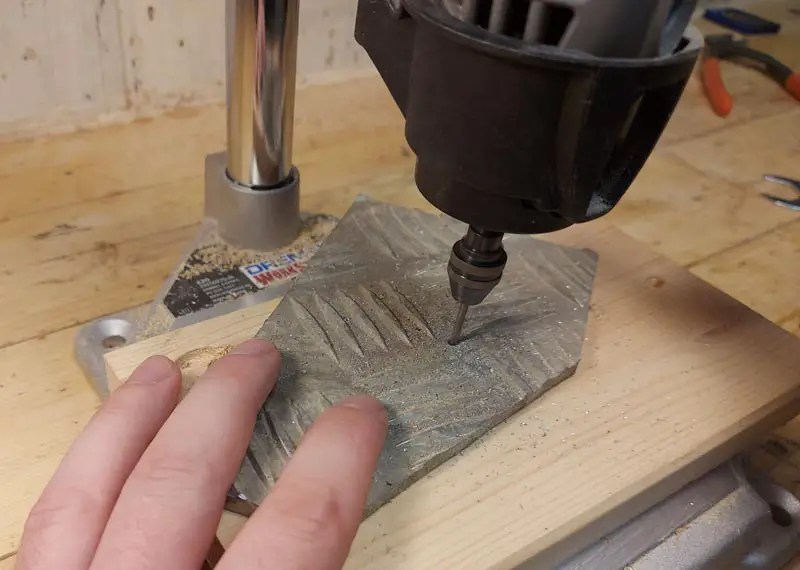

When drilling holes in metal with a Dremel we use the Metal Drill Bit Set #628. A Dremel will be able to drill through thin pieces of metal but works best for drilling through softer metals like aluminum because of the lower density.
To get precise holes when drilling metal with a Dremel it is best to use The Work Station #220-01. Cutting metal will take longer than cutting wood, so having something to keep the drill bit steady and to apply even pressure really helps.
When drilling deep holes in metal it is recommended to use something to lubricate the cut like a cutting fluid. This helps reduce the friction, reduces the heat buildup, and prolongs the life of your drill bits.
Personally, I would only use the Dremel to drill really small holes in metal. For metal pieces thicker than 1/8 inches (3mm) I would consider using a proper drill press.
Drilling Holes In Stone With A Dremel
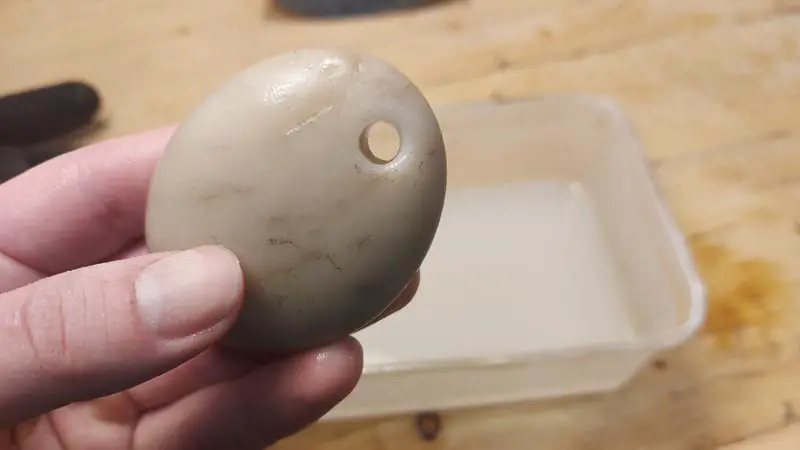
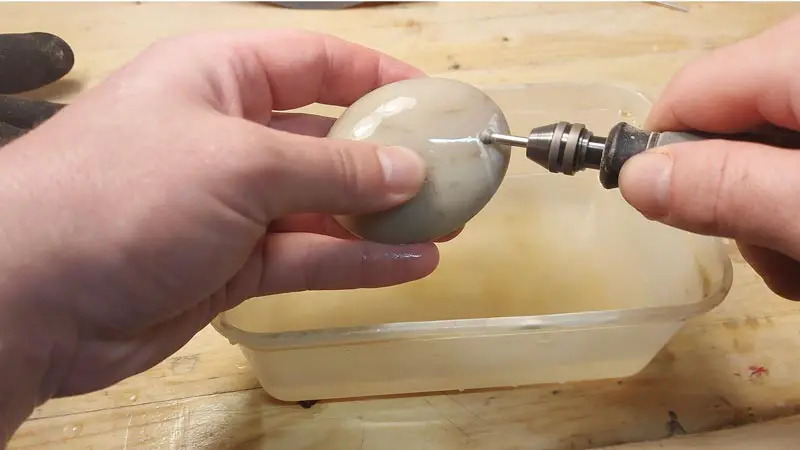
A Dremel is a great tool to drill holes through small stones. We use globe-shaped diamond bits to cut through the stone. Apply water while cutting to reduce stone dust and heat buildup and keep the water away from the motor. Cutting through stone requires some patience.
Diamond bits come in all shapes and sizes. But the best bits I have found for drilling through stone with a Dremel are the globe shape diamond bits. The globe shape of the bits secures a large cutting surface throughout the cut and also pulls the stone debris out of the cut.
The worst bits for cutting stone is the pointy diamond bits (in my opinion)
Water is very important when cutting stone. You can use several different techniques to apply water to the cut. You can:
- Submerge the stone slightly underwater while cutting
- Frequently dip the stone in water when it runs dry
- Or have a continuous stream of water dripping onto the stone while cutting
We also want to avoid water from getting into the motor and electrical system when cutting stone. My solution is to use the Dremel Flex Shaft #225, this leaves the motor far away from the water when cutting.
If you do not have the Flex Shaft then you can still use the Dremel as it is, but just be very careful not to spill water into the Dremel itself.
Drilling the actual hole into the stone is very simple once you are set up. Just start drilling and continue until you are through. But remember, you are dealing with a very hard material so you need to have some patience and not push the Dremel too hard.
The stone on the picture is about 2/5 inches (1cm) and took me 10 minutes to get through.
Drilling Holes In Glass With A Dremel
When drilling a hole in glass with a Dremel we use diamond-coated bits. We add water to the cut to reduce dust and heat buildup. Slowly cut through the glass with the diamond bit, but avoid water from getting into the motor and electrical system of the Dremel.
Cutting glass is very similar to cutting stone when using a Dremel. But since glass usually is thinner than stone we have a little bit more flexibility as to what shape of diamond bit we want to use.
I recommend using The #663DR Diamond Coated Bit for drilling holes through the glass, and the #EZ545 Diamond Wheel for cutting straight lines.
Use the same methods for adding water as explained in drilling through stone and the same precautions.
Drilling Holes In Plastic with a Dremel
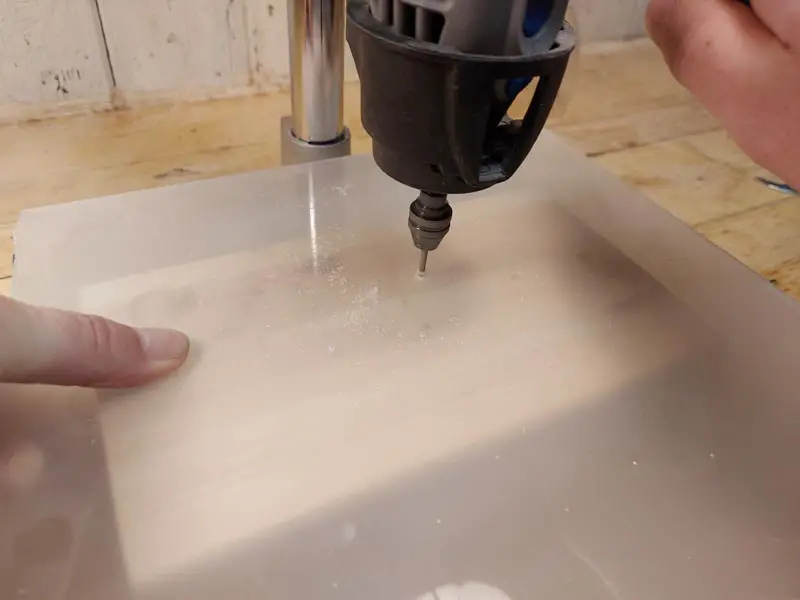

When drilling holes in plastic with a Dremel we can use all the drill bits we would use for metal or wood. We use a low RPM to reduce friction, this reduces the chance of the plastic heating up and melting. A Dremel can drill holes into plastic that is about 1/4-inches (6.5mm) thick.
Drilling through the plastic with a Dremel is pretty straightforward. But there are some tips and tricks I can share with you.
The plastic has a tendency to heat up to the melting point when drilling it. When this happens the plastic will harden onto the bit and clog it up. It will harden and it can be a pain to get it off.
To avoid plastic from clogging up the bit we reduce the RPMs of the Dremel to reduce the friction and heat buildup.
You can also try to add a little bit of water to the cut to cool the plastic down while cutting.
If you are drilling a flat piece of plastic, then lay a piece of wood underneath it before cutting to avoid making ugly marks on your workbench.
The Dremel Work Station #220-01 is also great when cutting plastic. It increases stability and gives you a lot more control when doing the cut.
